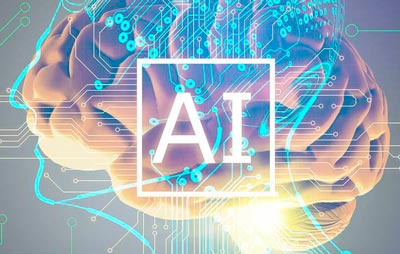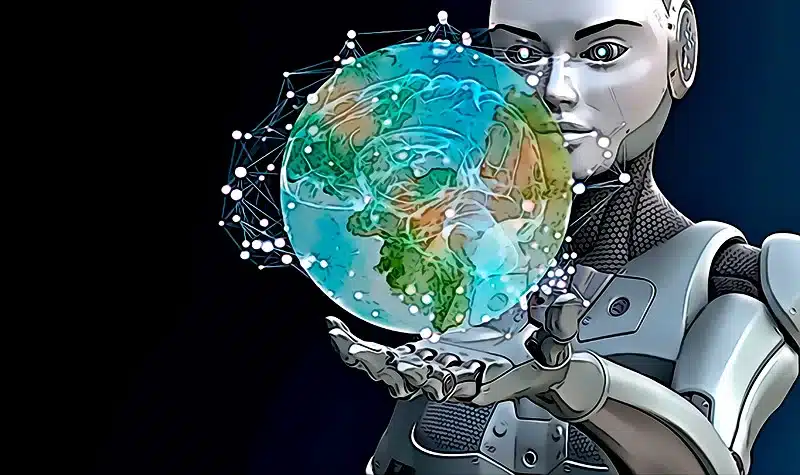On the horizon of technological evolution, user experience (UX) and artificial intelligence (AI) emerge as driving forces, delineating a digital landscape where human-machine interaction reaches new levels of sophistication. This development delves into the essence of specialized expertise, personalized strategies, and the optimization of time and resources, shaping a future where technology becomes an integral extension of our daily lives. (Artificial)
In the ever-evolving landscape of technology, the merger between user experience (UX) and artificial intelligence (AI) proves to be a catalyst for change. This breakthrough redefines the digital landscape, taking human-machine interaction to unexplored levels of sophistication. At the heart of this transformation lies the essence of specialized experiences, personalized strategies and the efficient optimization of time and resources. We are heading toward a future where technology becomes an integral extension of our daily lives.
In the dynamic fabric of today’s technological age, the synergy between user-centered design (UX) and artificial intelligence (AI) emerges as a driver of innovation and transformation. This intertwining redefines the digital experience by transcending conventional boundaries, driving the evolution of more intuitive and adaptive interfaces. AI, as a strategic ally of UX, not only anticipates user needs, but also dynamically personalizes the interaction, creating a paradigm where technology adapts to us with unprecedented precision. In this journey, we witness how the convergence of UX and AI is a beacon that lights the way towards a more fluid and enriching interaction between humanity and technology.
I. User Experience: Beyond the Graphical Interface
User experience has become the epicenter of technological innovation. Beyond the mere graphical interface, it is about creating an environment where every digital interaction feels intuitive and enriching.
At the epicenter of technological innovation, user experience stands as a guiding light. It goes beyond the simple graphical interface, seeking to create an environment where every digital interaction feels intuitive and enriching. This approach redefines the relationship between humans and technology, leading the way to an era where usability and user satisfaction are the cornerstones of digital evolution.
In the era of digital transformation, user experience emerges as the pivotal element driving change and widespread adoption of new technologies. It is not limited to the visual surface of interfaces, but is intertwined with functionality and usability, guiding organizations toward creating solutions that are not only engaging, but also efficient and meaningful to users. This holistic approach not only improves user satisfaction, but also triggers a cascade of positive impacts on operational efficiency and competitiveness in the digital business landscape.
User-Centered Design: User-centered design stands as the cornerstone. Understanding user needs and expectations is essential to creating products and services that solve problems and improve everyday life.
Personalization of the Experience: Personalization is becoming the norm. Technology platforms, from social networks to shopping apps, are employing advanced algorithms to tailor the experience to individual preferences.
User Feedback Integration: User feedback is being integrated on an ongoing basis. Companies leverage user feedback to improve and adjust their products, ensuring constant evolution in response to changing needs.
Augmented Reality Immersion: Augmented reality (AR) emerges as a key component. From navigation applications to online shopping experiences, AR integration transforms digital interaction by overlaying digital information on the real world, bringing new dimensions to the user experience.
Intelligent Automation: Intelligent automation redefines processes. AI drives the automation of routine tasks, allowing users to focus on more meaningful activities. From virtual assistants to customer service systems, intelligent automation becomes an ally in simplifying and improving daily life.
Emphasis on Technological Ethics: Technological ethics take center stage. With the growing influence of AI in our lives, ethical considerations, such as privacy and fairness, become fundamental aspects of technology design and implementation, ensuring responsible and respectful digital interaction.
II. Artificial Intelligence: The Brain Behind the Experience
Artificial intelligence stands as the catalyst behind the transformation of the user experience. From virtual assistants to recommendation systems, AI is woven into our daily routine.
At the very fabric of user experience transformation, artificial intelligence stands as a master architect. From virtual assistants that anticipate our needs to recommendation systems that map a personalized path, AI is invisibly woven into our daily routine. This journey of innovation redefines human interaction with technology, forging a future where artificial intelligence not only assists, but also anticipates and elevates every digital experience.
The Convergence of Technologies: The intersection of diverse technologies such as augmented reality, artificial intelligence and ultra-fast connectivity gives way to a powerful synergy. The convergence of these technologies not only enhances the user experience, but also creates interactive digital ecosystems that transcend traditional limitations.
New Interaction Paradigms: New paradigms of human-machine interaction are emerging. From neural interfaces that enable brain commands to wearable devices that transform gestures into digital actions, the evolution of user interfaces redefines the way we interact with technology, bringing us closer to more natural and immersive experiences.
Digital sustainability: Digital sustainability becomes imperative. The user experience is enriched not only with functionality, but also with environmental responsibility. The search for sustainable technological solutions and the reduction of ecological impact become essential elements for the continuous evolution of digital interaction.
Virtual Assistants and the Interaction Revolution: Virtual assistants, powered by artificial intelligence, redefine interaction. From Siri to Alexa, these digital entities not only respond to commands, but understand contexts and learn from user preferences over time.
Predictive Analytics and Personalized Strategies: Predictive analytics, powered by AI, enables personalized strategies. Companies can anticipate user needs, offering recommendations and services tailored to their previous behaviors.
Time and Resource Savings: AI becomes a tool for saving time and resources. From task automation to process optimization, artificial intelligence frees up human capabilities for more creative and strategic tasks.
Augmented Reality and Business Transformation: Augmented reality (AR) emerges as a transformative technology in business interaction. From empowering employees through immersive experiences to enhancing product visualization, AR redefines how businesses operate and connect with their audiences.
Ethics in Artificial Intelligence: As artificial intelligence becomes more integrated into our lives, ethics in its development and use becomes critical. Transparency in algorithms, fairness in data processing and consideration of ethical implications are essential components to ensure a fair and responsible integration of artificial intelligence into society.
Cultural Transformation: The convergence of UX and AI not only drives technological transformation, but also a cultural transformation. Adaptability to new forms of interaction, openness to continuous innovation and a user-centric mindset become key factors to embrace and make the most of this digital revolution.
III. Relevant Keywords:
User Experience
Artificial Intelligence
Personalization
Automation
Virtual Assistants
User-Centered Design
Predictive Analytics
Technological Innovation
IV. Automation in the Enterprise World: Efficiency and Personalized Strategies
Enterprise automation stands out as an area where efficiency and personalization converge. Organizations adopt automated technologies to streamline processes and, at the same time, offer solutions more tailored to individual needs.
At the very heart of the business revolution, automation emerges as a beacon where efficiency and personalization go hand in hand. Organizations are enthusiastically embracing automated technologies, charting a course that not only accelerates processes, but also models solutions meticulously tailored to individual needs. This transformative paradigm redefines the relationship between business and technology, merging operational speed with unparalleled attention to personalized detail.
Cybersecurity Strategies: In the digitized business environment, cybersecurity strategies become critical. Data protection, attack prevention and rapid response to potential threats are essential to ensure integrity and trust in business operations.
Blockchain and Business Transformation: Blockchain technology, known primarily for backing cryptocurrencies, is transforming the way businesses manage security, traceability and transparency in transactions. From smart contracts to supply chains, blockchain is positioned as a pillar in redefining business processes.
Corporate Sustainability: Sustainability becomes an essential component of business strategy. Organizations adopt sustainable practices not only as a social responsibility, but also as a driver of long-term efficiency and competitiveness.
Automated Business Processes: Business process automation has become ubiquitous. From human resource management to the supply chain, companies are looking to automated systems to improve efficiency and reduce errors.
Personalized Marketing and Sales: In marketing and sales, automation enables personalized strategies. Algorithms analyze customer data, delivering campaigns tailored to individual preferences and buying behaviors.
Chatbots and Customer Service Integration: The incorporation of chatbots, powered by AI, transforms customer service. These virtual agents not only respond to queries, but also learn from interactions to provide more accurate and personalized responses.
Data Analytics and Decision Making: Data analytics stands as a pillar for business decision making. Companies collect and analyze large amounts of data to gain valuable insights, supporting informed decisions and effective strategies.
Agile Project Management: Agile project management becomes a crucial methodology for companies in dynamic environments. Flexibility and collaboration are key in the implementation of projects, allowing to quickly adapt to changes and optimize the delivery of results.
Open Innovation and Collaboration: Open innovation and collaboration are positioned as drivers of business creativity. Companies seek external partnerships, collaborations and community contributions to foster innovation and stay ahead in their industries.
V. Saving Time and Resources: Global Perspective
Saving time and resources through technology is not only limited to the individual or enterprise level, but also expands on a global scale.
In the very fabric of our global interconnectedness, the optimization of time and resources through technology not only stands as an individual or corporate achievement, but also expands as a symphony that resonates on a planetary scale. This transformative phenomenon not only redefines local efficiency, but weaves an intercontinental network of agile processes, connecting and benefiting entire communities. Technology, in this context, emerges as the engine that drives not only productivity, but also collaboration and shared prosperity in the global village.
Sustainability and Technology: Sustainability becomes a technology-driven backbone. From smart resource management to the creation of eco-efficient solutions, technology plays a key role in building a sustainable future. In this context, technological innovation becomes an essential ally in addressing environmental challenges and promoting practices that ensure the preservation of the planet for future generations.
Social Transformation: Technology also triggers social transformation at a global level. With instant connectivity through digital platforms and social networks, communities around the world can share experiences, knowledge and resources immediately. This global interconnectedness fosters mutual understanding, solidarity and the ability to address social problems on an unprecedented scale. Ultimately, technology stands as a catalyst for building a more equitable and inclusive world.
Automation in Industrial Production: In the industrial sector, automation has revolutionized production. From automobile factories to assembly plants, robotics and automation ensure greater efficiency and quality in manufacturing.
Resource Management in Smart Cities: Smart cities leverage technology to manage resources efficiently. From traffic management to energy conservation, automation contributes to the creation of more sustainable urban environments.
Healthcare and Life Sciences: Automation in Discovery: In healthcare, automation extends to scientific discovery. Robotics and artificial intelligence accelerate research, from drug screening to identifying new therapies.
VI. Challenges and Ethical Considerations in Full Automation
While total automation promises numerous benefits, it also poses challenges and ethical considerations that must be addressed.
On the horizon of total automation, where the promises of efficiency and productivity are tantalizing, a set of challenges and ethical issues emerge that demand our attention. This technological landscape, while full of promise, invites us to reflect on responsibility and integrity in the implementation of automated systems. The journey towards full automation requires not only technical ingenuity, but also an ethical compass to guide our decisions to ensure that each advance contributes not only to efficiency, but also to well-being and equity in society.
Labor Displacement and Reskilling: Labor displacement is a critical challenge. Companies must embrace reskilling strategies to ensure that workers acquire the skills needed in the new employment landscape.
Data Privacy: Mass data collection raises privacy concerns. Companies must establish transparent and secure practices in managing user information.
Equity of Access: Full automation could widen the digital divide. It is essential to ensure equity in access to technology to avoid exclusion of segments of the population.
VII. The Future of Automation: Human-Machine Collaboration
Looking to the future, the key lies in harmonious collaboration between humans and machines.
At the crossroads of the future, we envision a path where harmonious collaboration between human creativity and machine power becomes the master key. This horizon not only challenges us to embrace intelligent coexistence, but also urges us to forge a symphony where human dexterity and artificial intelligence efficiency converge to sculpt a tomorrow full of possibilities and progress.
Ethical Development of AI: Ethics in the development of artificial intelligence becomes crucial. The creation of ethical systems and the incorporation of human values are fundamental for a harmonious coexistence.
Education for the Digital Age: Education becomes the cornerstone. Preparing for the digital age implies a reconfiguration of education systems to equip future generations with relevant skills.
Continuous Innovation: Constant innovation is essential. Businesses and governments must foster an environment conducive to research and development, enabling continuous advances in full automation.
Conclusion: Navigating toward a User-Centric Technology Era and Artificial Intelligence
The convergence of user experience and artificial intelligence redefines our relationship with technology. From creating friendlier interfaces to anticipating our needs, we are on the cusp of a revolution that will transform the way we interact with the digital world. As we move forward, it is crucial to embrace these trends, seize the opportunities they offer and understand the importance of a technology that is ultimately focused on improving our lives. Welcome to the era of user-centric experience and artificial intelligence!
Full automation is shaping a world where user experience and artificial intelligence are the pillars of digital interaction. From the individual sphere to the global arena, technology is redefining the way we live and work. As we embark on this journey, it is essential to approach challenges with resilience and ethical guidance, ensuring that technology remains instrumental in improving the quality of life. Welcome to a future where human-machine collaboration leads the way to excellence in total automation!
Tips:
Gradual Adoption: If you are a company or professional interested in implementing full automation, consider adopting these technologies gradually. Start by identifying specific areas where automation can make a significant difference and then expand as needed.
Continuing Education: For workers and professionals, continuing education is essential. Stay current with the latest trends in artificial intelligence and automation. Participate in courses and learning programs to acquire new skills relevant to the digital world.
Ethical Considerations: If you are part of the development of automated technologies, be aware of ethical considerations. Ensure that data collection and use is ethical, and work to minimize any negative impact on employment.
Interdisciplinary Collaboration: Encourage collaboration between different disciplines. Full automation often involves the convergence of expertise in computer science, ethics, design and many other areas. Interdisciplinary collaboration can generate more holistic solutions.
Adaptability and Resilience: Full automation can generate changes in work dynamics. Develop adaptability and resilience skills to deal with any changes in the work environment. This could involve learning new skills or reinventing your professional approach.
Understand User Needs: If you are involved in user experience design, thoroughly understand user needs and expectations. Conduct continuous testing and gather feedback to constantly improve user interaction with automated technologies.
Foster an Environment of Innovation: In enterprise environments, fosters a culture of innovation. Provides employees with the space and resources to propose ideas and solutions involving full automation and artificial intelligence.
Promote Ethics in Artificial Intelligence: If you work in artificial intelligence development, prioritize ethics. Ensure that algorithms are transparent, fair and non-discriminatory. Consider the social and ethical impacts of your solutions.
Remember that full automation is not only a technological evolution, but also a cultural change. The acceptance and successful integration of these technologies depends largely on how people and organizations adapt and address the associated challenges. Good luck!
In the fabric of total automation, we are faced not only with a technological revolution, but also a momentous cultural shift. Navigating this new paradigm requires not just technological ingenuity, but





